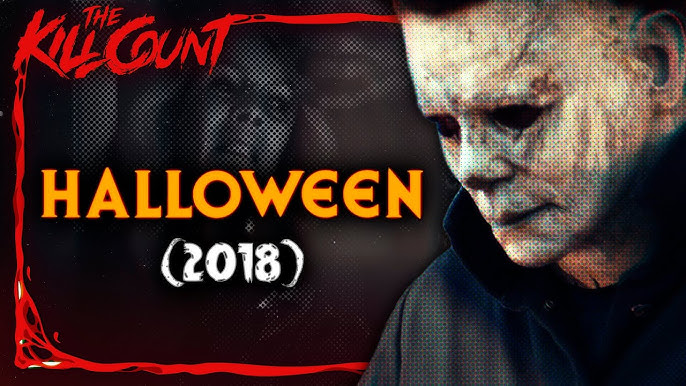Halloween (2018)

Halloween (2018) – Detailed Review
Genre: Horror, Thriller
Director: David Gordon Green
Main Cast: Jamie Lee Curtis (Laurie Strode), Judy Greer (Karen Nelson), Andi Matichak (Allyson Nelson), Will Patton (Deputy Frank Hawkins), James Jude Courtney (The Shape/Michael Myers), Nick Castle (Michael Myers)
Synopsis:
Halloween (2018) serves as a direct sequel to John Carpenter’s iconic 1978 film Halloween, ignoring the previous sequels and rebooting the story 40 years after the original. Laurie Strode, now a traumatized yet resilient woman, has spent her life preparing for Michael Myers’s return. Living in seclusion, Laurie has fortified her home and trained herself for a final confrontation with “The Shape.” Her estranged daughter, Karen, and granddaughter, Allyson, however, view Laurie as paranoid, despite her intense survival instincts. When Michael Myers escapes custody during a transfer, he returns to Haddonfield, setting the stage for a deadly confrontation with Laurie and her family.
Storytelling & Themes:
Halloween (2018) delves into themes of trauma, survival, and resilience. Laurie’s character arc reflects the psychological impact of living with fear for decades and the determination to overcome it. Her relentless preparation and “survivor mentality” show how trauma can shape a person’s life, for better or worse. The film also explores family dynamics, as Karen and Allyson struggle to understand Laurie’s need for control and protection. This generational rift highlights the impact of unresolved trauma on families, while the theme of women facing and overcoming violence is particularly relevant.
Performance:
Jamie Lee Curtis delivers a powerful, emotionally charged performance as Laurie Strode, capturing the depth of a character haunted by past horrors yet fueled by the desire to end them once and for all. Her portrayal adds gravitas to Laurie’s transformation from a frightened teenager in the original Halloween to a hardened, no-nonsense survivor. Judy Greer’s portrayal of Karen adds nuance, portraying her as someone who’s been raised with paranoia and is struggling to live a normal life. Andi Matichak as Allyson provides a fresh perspective as the granddaughter who becomes caught in the crossfire of Laurie and Michael’s long-standing conflict. James Jude Courtney and Nick Castle as Michael Myers/The Shape bring terrifying presence, reinforcing the idea of Michael as a silent, unstoppable force of evil.
Direction & Cinematography:
David Gordon Green’s direction pays homage to the original film while adding modern horror elements, balancing suspense and brutal intensity. The film uses long tracking shots, mirroring Carpenter’s 1978 style, to create an unsettling, voyeuristic experience as Michael stalks his victims. The camera often adopts Michael’s point of view, building suspense by making the audience feel like they’re right behind him. Michael Simmonds’ cinematography plays with shadow and light, heightening the tension and adding a gritty, authentic feel to the film. The shots of Laurie’s fortified home with its traps and weapons provide a stark contrast to the suburban streets of Haddonfield, emphasizing Laurie’s isolation and preparation.
Visual Effects & Design:
The visual effects and practical effects maintain the visceral brutality of Michael’s attacks without overrelying on gore. The mask design remains faithful to the original but aged to reflect Michael’s decades-long absence. Laurie’s house is meticulously designed, resembling a fortress, complete with hidden compartments, steel doors, and an arsenal of weapons, reflecting her life of preparation and fear.
Soundtrack:
John Carpenter returned to compose the score, reimagining his classic Halloween theme with a modern touch. The soundtrack uses minimalist, synth-heavy sounds to create a chilling atmosphere, combining nostalgia with heightened tension. Carpenter’s score amplifies key moments, using sharp, unsettling notes to mark Michael’s presence and enhance the suspense of stalking scenes.
Cultural Impact:
Halloween (2018) was well-received by both fans and critics, revitalizing the franchise by grounding it in Laurie’s journey of survival and reclamation. The film’s focus on trauma and its lasting effects resonated with audiences, sparking discussions about the impact of horror on survivors and how they reclaim agency. This installment’s success helped bring the slasher genre back into mainstream horror, blending nostalgia with a modern storyline and paving the way for further sequels that explore Laurie’s and Michael’s dynamic.
Conclusion:
Halloween (2018) is a suspenseful, intense continuation of the original story, offering a deep dive into the psychology of Laurie Strode while staying true to the classic horror roots. With Jamie Lee Curtis’s standout performance, Carpenter’s haunting score, and a balance of homage and innovation, the film delivers a satisfying and frightening return to Haddonfield. It’s a tribute to the original while adding depth to the legacy of Halloween, making it a must-watch for horror fans and an impactful chapter in the franchise.
Suggested Video for You:
Explore the making of Halloween (2018) and Jamie Lee Curtis’s perspective on reprising her role as Laurie Strode, diving into how the film addresses trauma, survival, and the legacy of one of horror’s most iconic
characters.

